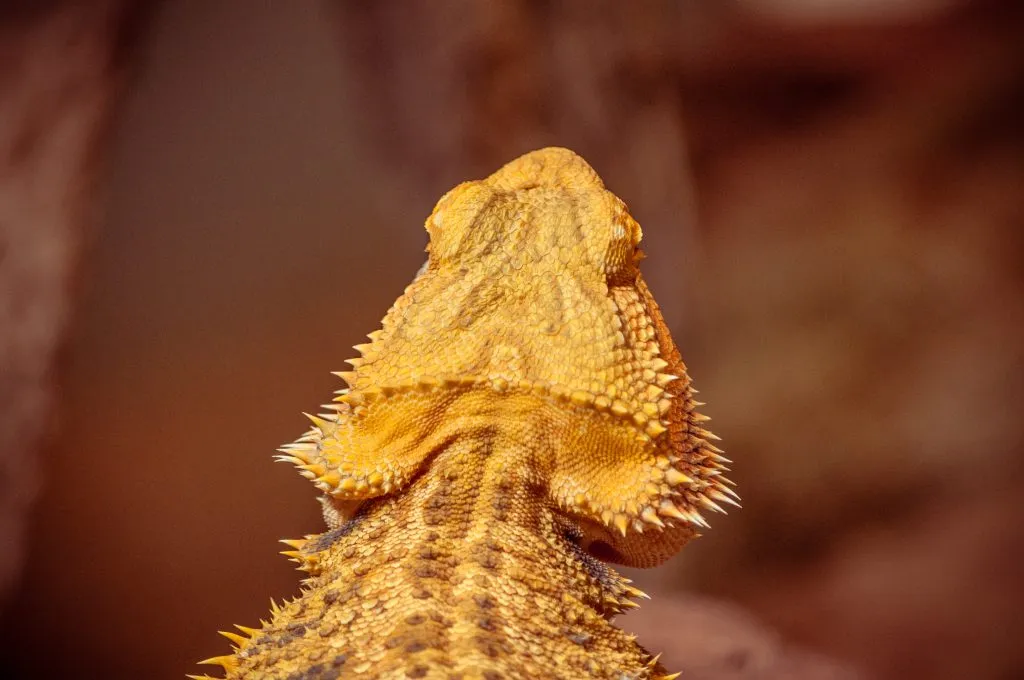
Bearded dragons have unique characteristics, and their actions often indicate how they feel. You may have noticed that your bearded dragon is lying on its back. Is that safe, and how long can they lay like that for?
Bearded dragons can not be left on their backs for long periods, as this can result in oxygen deprivation. They should be immediately flipped back over. Bearded dragons flip on their backs because of illness, head trauma, dehydration, overheating, or as a defense mechanism.
Bearded dragons can flip voluntarily or by accident onto their backs, so it’s important to know why they’re doing it and how long they should do it.
Table of Contents
How Long Can My Bearded Dragon Be on Its Back?
Your bearded dragon should not be left on its back for long periods of time. If you see your beardie has flipped onto its back and they are struggling to breathe, you need to turn them over.
Remember, a healthy bearded dragon will flip itself back over. If not, this is a sign that there is a problem.
This needs to be done immediately to prevent a possible lung collapse and suffocation. This is because bearded dragons do not have diaphragms that move like mammals, where the lungs inflate from contracting muscles.

Bearded dragons have intercostal muscles that are connected to the ribs, which are connected to the lungs. Unlike mammals, the bearded dragon’s ribs will inflate, signaling to the lungs to draw air.
When the bearded dragon lays on its back for too long, the muscles in the ribcage can relax, preventing incoming air and increased pressure. This is what leads to lung collapse.
This is a horrible and painful way for a beardie to die, so you must turn them over immediately to prevent this risk.
Reasons Why Your Bearded Dragon is on Its Back
Knowing why your bearded dragon is on its back can help you prevent them from doing it again or if you need to seek medical treatment.
Here are five possible reasons.
They are Sick
Atadenovirus is a common virus that is known to affect bearded dragons causing gastrointestinal problems as well as neurological issues. Flipping onto their back is a neurological issue.
If they keep flipping themselves over, you need to take your bearded dragon for a PCR test at a vet.
Another very common illness they might be suffering from is Yellow fungus disease.
This fungal disease can cause a lack of nutrition, so your beardie may be flipping over because they lost their balance and is disoriented.
Check for other signs, such as nausea and loss of appetite. A vet treats this.
Tip: If your bearded dragon appears to be very sick, read our article here. It will show you if your beardie is seriously sick and what you should do now.
Head Trauma
Your bearded dragon could have fallen and knocked their head.
If you witnessed your bearded dragon knock its head and now they’re flipping onto its back, this is a sign that they’re suffering head trauma and should see the vet immediately.
They are Dehydrated
Loss of water and electrolytes can cause your bearded dragon to become disorientated and lightheaded causing them to flip over onto their by mistake.
Make sure that their water bowl is always full and they can access it.
It’s a Defense Mechanism
If your bearded dragon is feeling threatened, it may flip on their backs to play dead.
If you have other animals nearby, like dogs, this might be causing stress. Keep your bearded dragon calm in a stress-free environment.
Tip: Read our article on stress in bearded dragons to learn how to reduce stress in your beardie!
They are Overheating

Your bearded dragon may have flipped onto its back to try to cool down.
While Bearded dragons do enjoy the warmth, they should have a cooler area of their enclosure at temperatures of 108-113°F (42-45°C) to cool down in.
Conclusion
You should not leave your bearded dragon on its back for long periods, especially if you see them struggling to breathe.
Your bearded dragon could be flipping over voluntarily to cool down, but continuous flipping over means that you need to take them for immediate medical attention.
- Enchi Ball Python: A Unique and Stunning Morph of Python regius - March 27, 2025
- Emerald Tree Monitor: The Enigmatic Green Guardian of the Rainforest - March 26, 2025
- The Egyptian Cobra (Naja haje): A Fascinating Serpent - March 25, 2025
